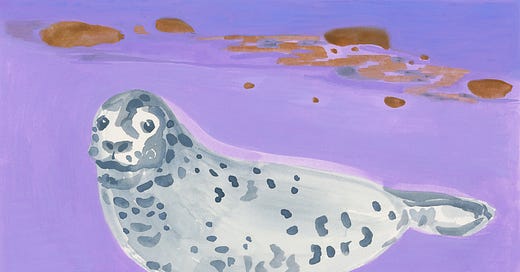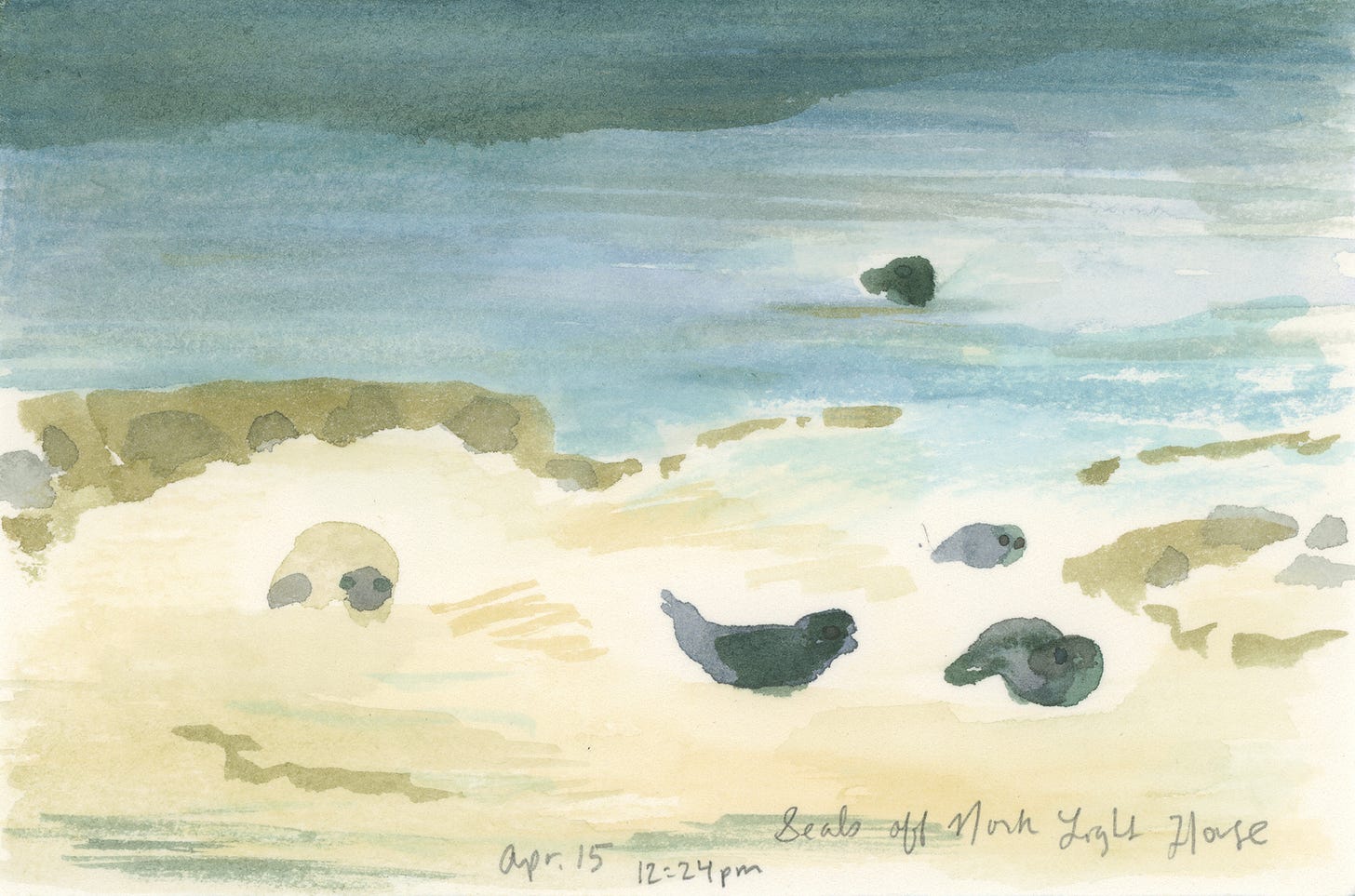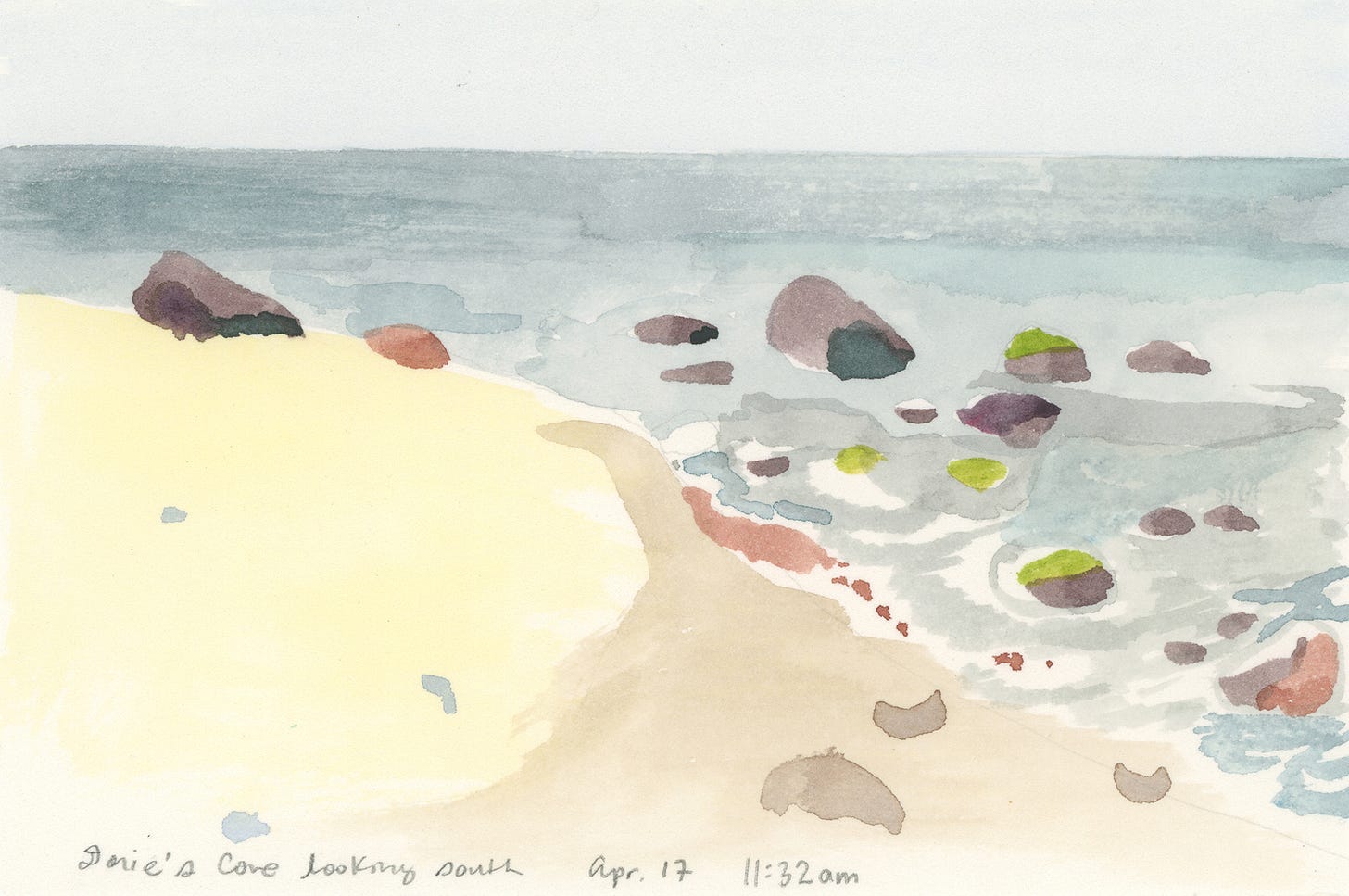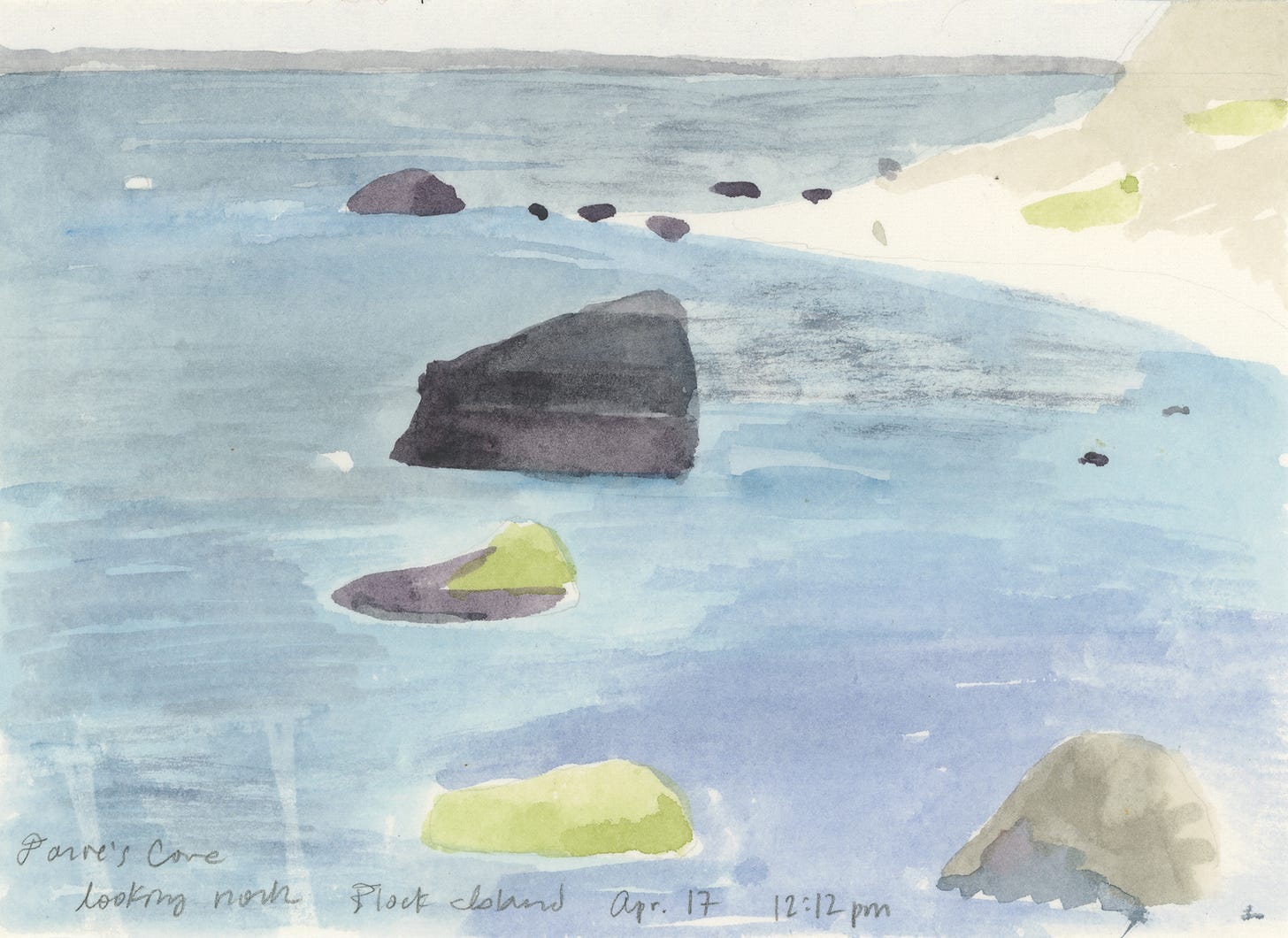Hello, friends — It’s April 1! Say “rabbit, rabbit” for good luck, and watch out for the Fools. The last few weeks have been slow and sloggy as late winter gives way. I’ve seen a giant snapping turtle walking over melting ice, a bobcat dashing under a fence, and a hooded merganser (a favorite duck) diving for its dinner. Last April, I spent a week on Block Island and became enamored of the smelly blobs sunning themselves on the northern point: packs of gray and harbor seals. Their little black eyes have stayed with me, inscrutable and unyielding. As always, please tell me your stories of animal encounters, let’s gather them up and give them a home. — Amy Jean
In April 2024, I had a one-week artist’s residency on Block Island off the coast of Connecticut and Rhode Island. Early spring is a blustery time of year there, and it reminded me of the west coast of Ireland where I lived and worked in my early twenties. I borrowed a bicycle and set out each morning with a backpack full of watercolors and paper. The island is about six miles long, and I rode my bike through wind and a little rain to the ends of roads, to lighthouses, beaches, and cliffs.
Block Island is a glacial moraine left after the last ice age. Large, worn boulders line its shores. As the waves roll in, the stones clack against each other and make a lonely sound. The boulders have been there all along, when the Niantic people called the land “Manisses,” island of the little god. Walking the trails alone, the island’s history felt strong, its battles just underfoot. On such a small island, you can imagine all the footsteps that came before you, all the ghosts lingering in the light.
On the north side of the island, the gulls appeared in pairs, on shallow nests in the dunes, caring for new eggs. On the same long stretch of sand, a colony of 100 seals stretched out in the sun and bobbed in the surf. When I sat on a rock to draw them, they looked up with sharp eyes, watching, questioning. They arrived for the first time during the pandemic and stayed.
I went back to the seals a few times, cycling out to the end of the road and walking the long beach. I was the only person out there sitting on a rock, trying to make myself small. Some of the seals were clumped in a big bunch, lounging and occasionally looking up or scratching their bellies. Some were dotted on the beach and almost indistinguishable from the boulders. At times I was surprised by what I thought was a rock that suddenly picked itself up and shuffled into the water.
There is a limit to how long a person can sit on a rock. When I stood up, the most cautious of the seals and smaller ones, maybe a dozen, lunged into the waves. There they popped their heads up fifty yards or so from the shore and watched. They kept a careful eye on me. If I turned my back, they seemed to get closer. They dove under the not-warm waves and popped up again and again. I shivered and packed up my bag. I could feel their eyes watching as I walked the long shore back. The gulls scuttled along beside me, making sure I didn’t stray.
In Irish folklore, the selkies are half-human, half-seal creatures. They can shed their seal skins and be human on land, or put their toes back into their seal tails and return to the water. They exist fully in two worlds. At the end of February, a gray seal pup was found on Chapel Street in New Haven. “Chappy” made headlines and was beloved for making his way to the city by the sea. Sadly, a seal can’t live in two worlds. Rescuers did their best to help Chappy, but he died in early March from an intestinal disorder.
It’s been a year since my encounter with the Block Island seals. I think of them often, of their watching me watch them, of our mutual looking across a divide. As I walked back to the road, their bobbing heads got smaller in the distance, blending in with the boulders. When I got to my bike, I threw my bag on my back and set off down the road. I stopped to watch bald eagles soaring over the shore and small kinglets in soft greens. I heard but never saw the northern flickers, hidden beyond dense trees.
Gray seal links—
“Gray seals can dive to 1,560 feet for as long as one hour.”— with gratitude to everyone working at NOAA Fisheries, you are essential.
“Why don’t diving seals drown? Scientists finally have an answer” — with gratitude to everyone at NPR, too, thank you.
Chris Ozyck on Chappy’s journey to New Haven—the early story of wonder and hope [News Channel 3]. And on the seal’s sad demise, with thanks again to NPR.
Favorite movie about selkies—John Sayles’s The Secret of Roan Inish [available on Kanopy]. Cartoon Saloon’s Song of the Sea is pretty wonderful, too.
Animal encounters in recent comments—
Send in your small stories, I saw a northern cardinal this morning, its bright red flashing through gray.
Also—
My lavender gray seal drawing is for sale. Some of the proceeds will go to the Block Island Conservancy.
Visual artists, there’s still time to apply for the Low Season Artist Residency on Block Island. Highly recommend!
Wild Life #49 / this monthly newsletter is a place to learn about the life around us, one intrepid gray seal at a time. I do this because I’m not sure what to do about the millions of species in danger of extinction. It means something to see and enjoy the life around us. Thanks for reading and sharing with family and friends.








Thank you for this magical post and for the NOAA love. I never tire of watching seals transform their blocky-looking little flippers into astoundingly flexy fingers for scritching themselves. This reminds me that we still have an elephant-seal-watching trip in our future! Sadly, sea lions, sea birds, and dolphins are stranding on our So Cal beaches daily right now due to an unusually early and intense harmful algal bloom. Our local NOAA Fisheries stranding response team, who determine cause of death for stranded dolphins and whales, has been working nonstop (it's all hands on deck at this point, so I participated in my first necropsy today!). On a gee-whizzier note, researchers recently documented coyotes preying on harbor seal pups in northern California, and published some pretty cool action shots: https://esajournals.onlinelibrary.wiley.com/doi/10.1002/ecy.70031 (beware, there are also some photos that are not for the squeamish)
Oh, you’ve made me long for a visit to Block Island! I didn’t know the seals had come to stay. Little Rocks, shuffling into the water, bobbing their sweet heads.